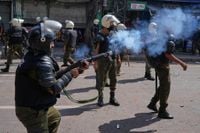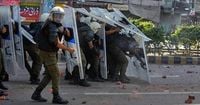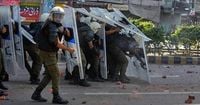Violent clashes erupted in Lahore, Pakistan, on Friday, October 10, 2025, as police and Islamist activists faced off amid a tense standoff over a planned pro-Palestinian march to Islamabad. The unrest, which began a day earlier, quickly escalated as authorities moved to block thousands of members and supporters of the Tehreek-e-Labbaik Pakistan (TLP) party from reaching the nation’s capital, where they intended to stage a demonstration outside the US Embassy.
According to Associated Press and multiple news outlets, the situation in Lahore, the capital of Punjab province, deteriorated rapidly as police baton-charged demonstrators and fired tear gas in an effort to disperse the crowds. Protesters responded by hurling stones at officers, turning parts of the city into scenes of chaos. The violence was not confined to a single area—clashes broke out at numerous locations, especially near the main TLP office, affecting not only activists but also ordinary residents caught in the crossfire. Many locals struggled to return home, their routes blocked by barricades and clouds of tear gas lingering in the air.
The TLP, a party known for its disruptive and sometimes violent protests, claimed that two of its supporters had been killed and 50 others injured since Thursday, October 9. The party’s statement was widely reported, but the Punjab provincial government, led by Chief Minister Maryam Nawaz Sharif—niece of Prime Minister Shehbaz Sharif—offered no immediate response to these allegations. The silence from provincial authorities only fueled speculation and frustration among TLP supporters and critics alike.
The march was set against the backdrop of a major international development: a ceasefire plan between Hamas and Israel, brokered by US President Donald Trump, had just come into effect. Despite the truce, the TLP pressed on with its plans, insisting on the need to show solidarity with Palestinians. Addressing thousands of worshippers during Friday prayers, TLP chief Saad Rizvi declared, "We will now march from Lahore to the US Embassy in Islamabad. Arrest is not a problem, bullets are not a problem, shells are not a problem — martyrdom is our destiny." His fiery words, reported by AP and echoed across social media, galvanized his followers, many of whom seemed undeterred by the prospect of violence or arrest.
The authorities, however, were determined to prevent the demonstrators from reaching Islamabad, which lies about 350 kilometers (210 miles) from Lahore. The federal government, under Prime Minister Shehbaz Sharif, took sweeping measures: mobile internet services were suspended in both Islamabad and the neighboring city of Rawalpindi, a move aimed at disrupting the protesters’ ability to coordinate and gather in large numbers. Meanwhile, shipping containers were placed across highways and major roads leading to the capital, turning thoroughfares into makeshift fortresses and leaving commuters stranded or forced to take long, circuitous detours.
The impact of the unrest was felt far beyond the immediate protest sites. In Lahore, a city of over 14 million, authorities ordered the closure of all schools, colleges, and universities on Friday, disrupting the lives of students and families. Daily routines were upended as residents found themselves navigating a city in lockdown, with many reporting difficulty reaching their homes or workplaces due to blocked roads and ongoing clashes. The closure of educational institutions underscored the seriousness of the situation, as officials sought to minimize the risk to young people and avoid further escalation.
Adding to the unease, the US Embassy in Islamabad issued a security alert ahead of the planned march, warning of "large crowds and traffic congestion," as well as "a precautionary security presence, an increased number of checkpoints, and associated disruptions to local mobile and internet networks in the region." The embassy urged American citizens to avoid large gatherings, stay alert, and keep a low profile, noting that the duration of the protests was unknown. The advisory reflected the unpredictability of the situation and the potential for further unrest.
Deputy Interior Minister Talal Chaudhry stated on Thursday that the TLP had not submitted a request for permission to hold the rally, a claim the group swiftly denied. TLP representatives insisted they had applied for permission to stage what they described as a peaceful march in solidarity with Palestinians. This dispute over the legality of the march became a flashpoint, with critics on both sides questioning the government’s response. While some citizens accused the TLP of provoking unrest and risking public safety, others argued that the authorities had overreacted by blocking roads and suspending services even before the demonstrators began their journey.
The Punjab government’s imposition of prohibitory orders under Section 144—effectively banning all public gatherings and rallies for ten days—added another layer of tension. This move, intended to restore order, drew both support and criticism online. Many social media users pointed to the TLP’s history of disruptive demonstrations, expressing concern about public safety. Others, however, saw the government’s preemptive actions as heavy-handed, especially given the context of a newly established ceasefire in the Middle East.
The disruption was not limited to activists and officials. Ordinary Pakistanis, particularly those living or working in and around Lahore and Islamabad, found themselves caught in the middle. Mohammad Ashfaq, a 35-year-old resident, voiced his frustration after being turned back at a roadblock in Islamabad. "Why are these demonstrators coming to Islamabad for the rally when the peace process has already started in Palestine?" he asked. "I tried using longer routes to reach the city, but police had also blocked those roads with shipping containers. Now I'll have to figure out again how to reach my office." His experience mirrored that of many others, as daily life became a logistical challenge.
For now, the situation remains tense, with neither side showing signs of backing down. The TLP’s leadership continues to mobilize supporters, while the government stands firm in its efforts to maintain order and prevent the protest from reaching Islamabad. The events in Lahore serve as a stark reminder of the complex interplay between political activism, public safety, and freedom of assembly in Pakistan—a country where such confrontations are far from rare, but where the stakes always feel high.
As the dust settles, residents of Lahore and Islamabad are left to contend with the aftermath: disrupted routines, uncertainty about what comes next, and the hope that peace—both at home and abroad—can prevail, even if only for a while.



